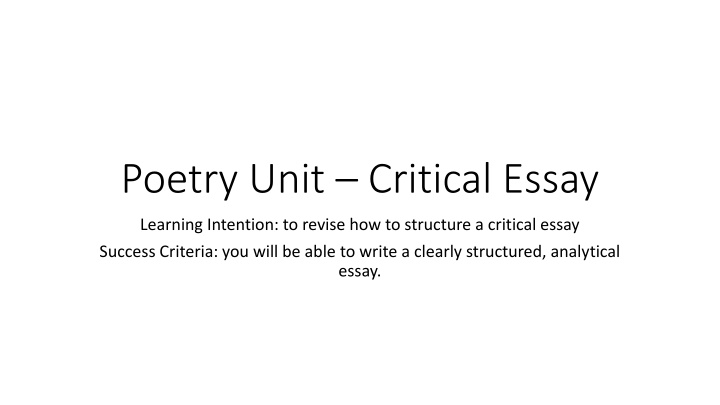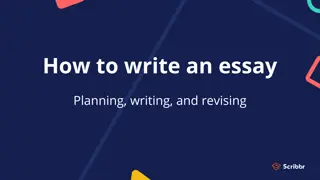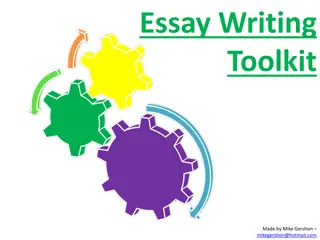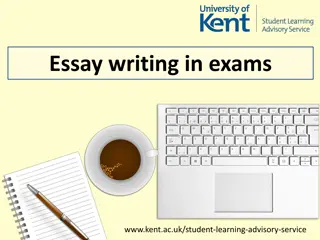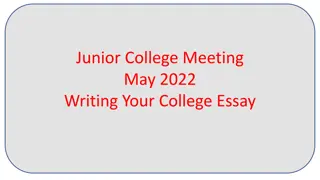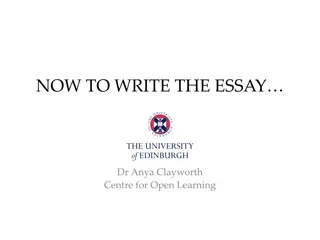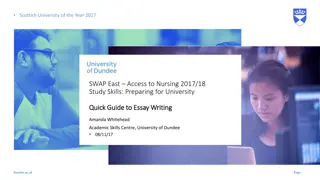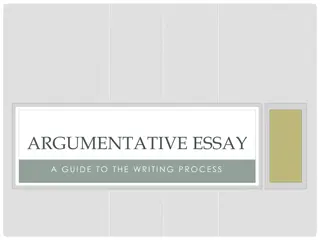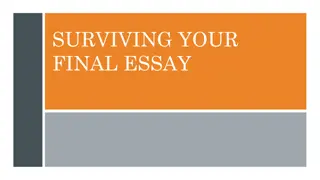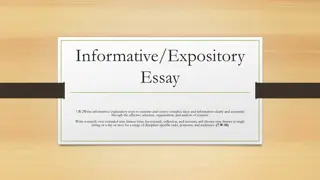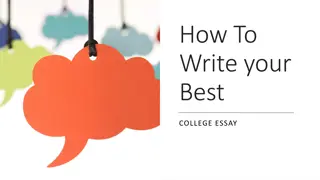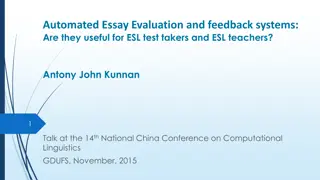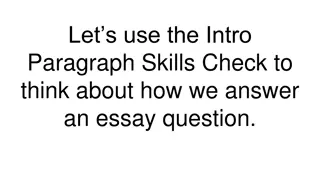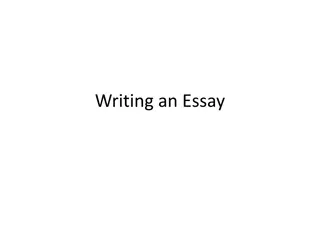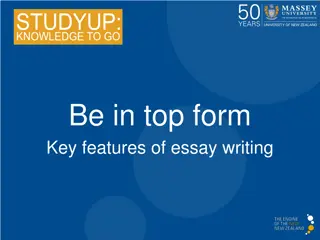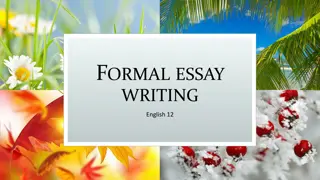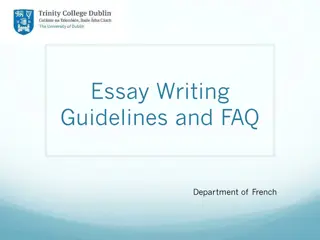Mastering the Structure of a Critical Essay
Enhance your critical essay writing skills by analyzing a thought-provoking poem, applying poetic techniques to explain its impact. Incorporate the PEE structure, integrate relevant quotes effectively, and use appropriate literary terminology for a clear and analytical essay.
Download Presentation

Please find below an Image/Link to download the presentation.
The content on the website is provided AS IS for your information and personal use only. It may not be sold, licensed, or shared on other websites without obtaining consent from the author.If you encounter any issues during the download, it is possible that the publisher has removed the file from their server.
You are allowed to download the files provided on this website for personal or commercial use, subject to the condition that they are used lawfully. All files are the property of their respective owners.
The content on the website is provided AS IS for your information and personal use only. It may not be sold, licensed, or shared on other websites without obtaining consent from the author.
E N D
Presentation Transcript
Poetry Unit Critical Essay Learning Intention: to revise how to structure a critical essay Success Criteria: you will be able to write a clearly structured, analytical essay.
Assessment Task You are going to write a critical essay analysing a poem of your choice: Choose a poem which you find particularly thought-provoking. By referring to poetic techniques, explain how the poet makes this poem so thought-provoking. You have studied 5 poems in this unit so you may choose to use one of those. Equally, you may have completed the extension task and produced a spoken analysis of a different poem that you have researched independently. Just ensure that you make it clear in the introduction as to which poem you are discussing.
This is not new to you! As we have worked through the unit and, indeed, your S3 year in English, you have been learning how to write critical essays. You know about the PEE structure. You know how to integrate quotes so they fit in with the flow of your sentence. You know the Explain bit is where you analyse what the writer is trying to do by using that image or making that point. You know that you are expected to use the correct terminology (the right word for the right device e.g. a metaphor , not one of those comparison thingies !)
Additional Reminders Do put quotes in quote marks Do not use first person I in your essay, except for a personal comment in your conclusion. Do not use the phrase In this essay Do not use the phrase The quote that shows this is or anything similar. Do pick a word from your evidence to analyse in more detail and talk about the connotations of that word. Do write an introduction and conclusion. I will explain a few of these in more detail on the next slides.
Do not use first person I in your essay, except for a personal comment in your conclusion. Look at the difference between these two sentences: 1. I think Nichols uses a metaphor to suggest 2. Nichols uses a metaphor to suggest No. 1 sounds tentative, as if you are unsure, and as if only you think this. No. 2 sounds more confident and informed as if you are objectively stating a fact. It is more formal and academic.
Do not use the phrase In this essay You want to write in an objective, analytical way rather than reminding your reader this is an essay. Look at the difference: 1. In this essay, I will analyse how Tennyson uses range of poetic devices to present the nobility of the Light Brigade. 2. Tennyson uses range of poetic devices to present the nobility of the Light Brigade. No.1 forces you to use I and states the obvious. No.2 sounds more informed and confident. It is also obvious that you are going to talk about the devices.
Do not use the phrase The quote that shows this is or anything similar. If you do, it means you have not integrated your quotes. 1. Nichols uses a metaphor to explain how precious the island is to Island man. The quote that shows this is, small emerald isle . It implies SHOULD BE: 2. Nichols uses the metaphor, small emerald isle to explain how precious the island is to Island man. It implies No.2 requires fewer words (handy in a timed exam) and the quote fits in with the flow of the sentence.
Lets unpick the question 5. Choose a poem which you find particularly thought-provoking. By referring to poetic techniques, explain how the poet makes this poem so thought-provoking. Make a few notes: So, what does it cause (provoke) you to think about? Why? Was it the poet s purpose to make you think about this subject? Where in the poem do you think this? Why? Which devices make you think these things? How?
Revision: Structuring Analytical Paragraphs Start every paragraph with a topic sentence that uses the wording of the task or at least addresses it. Apply the PEE chain. Make a Point. (For this question, it will be about what thoughts are provoked, or about a device used.) Back it up with Evidence. Explain/analyse your evidence in relation to the task. (In this case how the quote/device provokes these thoughts in the reader.) Remember to use the technical language in either your point or your analysis.
Remember this from Blessing? It shows you how to analyse poetic devices Device Simile Quote The skin cracks like a pod Effect you must fill this in in detail. By comparing the people s skin to a seed pod, it suggests it is dry and brittle. She may also be implying that just as seeds need water to grow and thrive, so too do these people. The image of skin being cracked makes it sound painful so the reader sympathises with the people. Reflects sound of water. To help us understand how it might feel to be imagining the sound of water when we have none. onomatopoeia drip splash An imperative verb (telling the reader to do something) Imagine The poet is asking us to put ourselves in the position of the people in the poem. We do not normally need to imagine the sound of water as we hear it all the time but she wants us to realise that to them it is a joyous sound. This line is not poetic or complex. Instead it is a simple comment designed to help us understand the facts of the situation at the start of the poem. This metaphor implies that water is viewed as a gift from a god. It is as if a god s love is raining down on them in a very practical form. Having water is like a miracle to them. (Note: no capital letter for god in the poem as India has many gods.) The word congregation usually refers to a group of worshippers in a church or temple. However, here they are worshipping the around the water that they believe has been sent by a god. It reflects that in the scrabble for water, there is no space or separation between man woman or child. The comparison to silver implies the water is precious to them and having access to it is a moment of good fortune. It also reflects the colour of the water so the reader can imagine it flooding out of the pipe. frantic suggests people are desperate to get the water while it lasts. Butts suggests everyone is crowded together pushing and shoving each other. There is no time to be polite. A concise, direct, factual statement ending in a full stop. Metaphor There is never enough water. The voice of a kindly god. Religious imagery a congregation Omitting the commas in a list every man woman child for streets around Metaphor to reflect value of water. Silver crashes to the ground Words to show desperation, excitement or panic. frantic butts
Remember this from Island Man? Use it to revise the structure of your paragraphs. Sample P.E.E paragraph the point is highlighted green, the evidence is in pink, and the explanation is in blue. You can see that two comments are made in the explanation as the quote is fully analysed; the quote is integrated and correctly terminology (metaphor) is used to state the devices. Nichols uses a metaphor to describe how the island man feels about his island. She refers to, his small emerald island . This suggests it is a very precious place to him and something he cherishes. It also creates a picture of a green and lush island which is a beautiful place to be so the reader begins to understand why he misses his island so much.
Remember this from Sonnet 116? Look at it again to remind you of how to explain and analyse your evidence. Point Evidence Explain Shakespeare uses a metaphor to explain how love is not affected by time. Love s not Time s fool The personification of Love and Time suggests time tries to outwit (fool) love by ageing and trying to remove the beauty of a lover. Shakespeare implies that true love would never be fooled in this way and is not affected by the passing of time. Shakespeare is celebrating love in this poem. He feels that no obstacles should be able to impede the course of true love. The implication is that if obstacles do get in the way, then it was not true love to begin with. Let me not to the marriage of true minds Admit impediments. By comparing love to the North Star, he is suggesting it should be valued beyond price. It is the star Whose worth's unknown Just as the star is an invaluable guide to sailors because it can save them from danger, true love is priceless. It is something precious and worth protecting. He may also be suggesting that true love can save lost or wandering souls, perhaps giving meaning to their lives.
Writing your introduction 1. INTRODUCTION: Name of the poet; Name of the poem; Use the wording of the task and respond to the question; Brief summary of the poem; Comment on writer s purpose. DO NOT REFER TO YOURSELF DO NOT REFER TO THE ESSAY
Sample Introduction Sample Introduction Read the comments to help you unpick Read the comments to help you unpick the introduction and check everything from our list is included the introduction and check everything from our list is included The Charge of the Light Brigade is a poem written by Alfred Lord Tennyson in 1854. It is based on a true event when a six hundred strong light brigade charged Russian cannons during the Crimean War. Tennyson read about the tragic loss of life in an article in The Times and wrote his poem to honour the Noble six hundred. The poem provokes thoughts about war and conflict and whether it is worth the loss of human life. It also makes the reader think about the themes of honour, courage and patriotism.
Quick Review So, you have your ideas about what thoughts the poem provokes and what devices are used. You ve been reminded how to structure the main paragraphs of your essay. You have revised how to write an introduction and have looked at an example. I suggest you now formulate your topic sentences. (i.e. decide what you want to discuss in each paragraph. It may be a thought the poem provokes, or a device you wish to analyse.) See the next slide for additional help.
Sample topic sentences topic sentences these make it clear what you are going to discuss in the paragraph Tennyson uses metaphors to help the reader understand the danger and sheer horror of the situation. Nichols wants the reader to understand how difficult it must be for someone who feels displaced from their own culture and homeland. Dharkar uses sound devices to build tension in her poem, and to help the reader understand the villagers excitement at the sound of water in their drought ridden land. Each of these sentences tells the reader what the paragraph will be about, and each addresses either a thought provoked by the poem or a device used in the poem, therefore it sticks to the essay task/question. Now write your own topic sentences aim for 4 or 5.
Remember our analytical language- this will help you introduce your analysis section. This suggests The words imply The phrase/word/image suggests The connotations of the word/phrase are This makes the reader think/feel The writer is attempting/trying to The ______ reiterates/reinforces/ repeats/recalls.. The rhythm represents The recurring image of By using this word/phrase/image, the writer is The writer encourages the reader to makes it sound like sounds as if gives the impression conveys a sense of The _____ echoes the idea/image creates a sense of Reflects the idea/sound of
Writing a Conclusion Mention again the name of the poem and the poet. Start with the words, In conclusion . Go back to the question and give a brief answer summing up what the main part of your essay has said. Mention the writer s message. You can, at this point, make a comment about your personal response and use I . A model conclusion is given on the next slide check it includes all of the above. (Use comment boxes.)
Choose a poem which you find particularly thought-provoking. By referring to poetic techniques, explain how the poet makes this poem so thought-provoking. In conclusion, The Charge of the Light Brigade is an incredibly thought provoking poem. A reader cannot help but think about the futility of war, the horror of the battlefield and the tragic loss of human life. However, just as Tennyson intended, we also cannot fail to be impressed by the courage and honour of these men who obeyed a mistaken order and fought so bravely against the odds. Tennyson wanted us to honour the Light Brigade and this is one command I am happy to obey.
Your turn! Now, please write a formal critical essay in response to the following question: Choose a poem which you find particularly thought-provoking. By referring to poetic techniques, explain how the poet makes this poem so thought-provoking. Aim for an introduction, 4-5 paragraphs then a conclusion.
